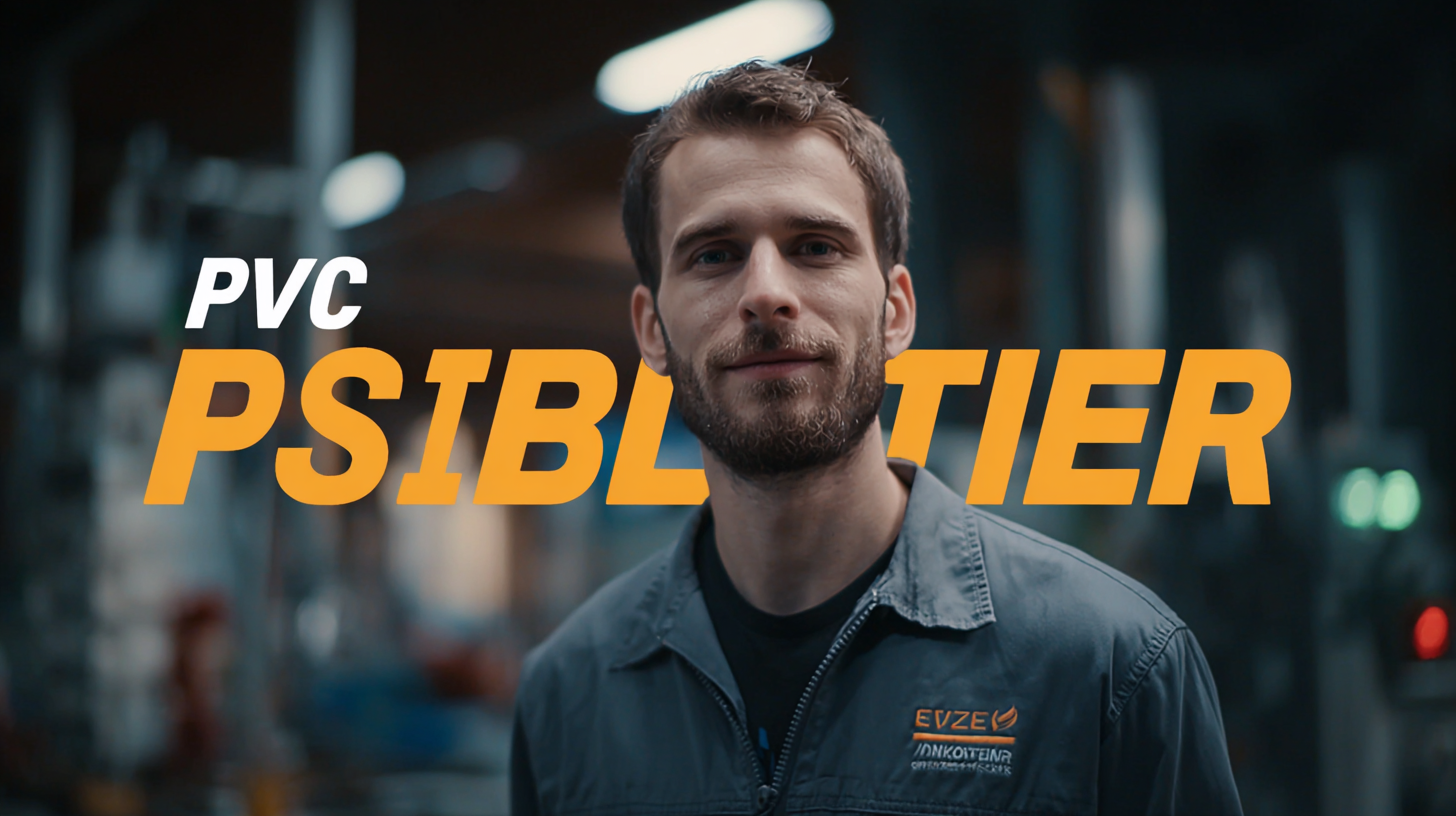
Understanding the Features and Applications of Different PVC Stabilizers and How to Choose the Right One
In the world of polymer manufacturing, PVC stabilizers play a crucial role in enhancing the performance and durability of polyvinyl chloride products. As the demand for PVC materials continues to rise, driven by its widespread applications in construction, automotive, and consumer goods, the global market for PVC stabilizers is expected to grow significantly, with a projected value of USD 2.1 billion by 2026, according to recent industry reports.

Understanding the various types of PVC stabilizers—such as lead-based, calcium-zinc, and organotin stabilizers—is essential for manufacturers striving for efficiency and compliance with environmental standards. This blog aims to delve into the features and applications of different PVC stabilizers, providing insights on how to choose the right one tailored to specific needs and regulatory requirements in an increasingly competitive market.
Understanding the Different Types of PVC Stabilizers: A Comprehensive Overview
In the realm of PVC manufacturing, the choice of stabilizers plays a crucial role in determining the durability and performance of the final product. There are primarily three types of PVC stabilizers: calcium-zinc, lead-based, and organotin stabilizers. According to a recent industry report by MarketsandMarkets, the global PVC stabilizers market is poised to grow from USD 1.2 billion in 2020 to USD 1.6 billion by 2025, highlighting the increasing significance of selecting the right type of stabilizer. Calcium-zinc stabilizers are gaining popularity due to their non-toxic properties, making them ideal for consumer products.
Lead-based stabilizers, while known for their efficiency, are facing declining demand due to environmental concerns and regulatory restrictions. The same report indicates that their market share has decreased significantly, as manufacturers shift towards more sustainable options. Organotin stabilizers, on the other hand, are known for their heat stability, but concerns about their toxicity are leading to increased scrutiny. The ongoing research into alternatives and the regulatory landscape is pushing manufacturers to adopt greener technologies. By understanding these types and their specific applications, manufacturers can make informed decisions that align with both performance needs and environmental standards.

Key Features of PVC Stabilizers: What to Look For in 2025
When selecting the right PVC stabilizer, it is essential to focus on key features that will influence the performance and longevity of your PVC products in 2025. One critical aspect is thermal stability, which ensures that the PVC material can withstand high processing temperatures without degrading. Look for stabilizers that provide excellent heat resistance to maintain product quality during manufacturing and usage. Additionally, the stabilizer should not adversely affect the physical properties of the PVC, such as flexibility and strength.
Another important feature to consider is the environmental compatibility of the stabilizer. As sustainability becomes a priority, opting for non-toxic, eco-friendly stabilizers is crucial. Many manufacturers are now producing stabilizers that meet stringent environmental regulations, which not only protect user safety but also enhance the recyclability of PVC products. Lastly, consider the compatibility of the stabilizer with other additives used in the formulation. A good stabilizer should work harmoniously with other components, ensuring optimal performance while minimizing any adverse reactions.
Applications of PVC Stabilizers Across Industries: Trends and Insights
PVC stabilizers play a crucial role across various industries, influencing product durability and performance. With the global artificial leather market projected to grow from $37.59 billion in 2025 to $57.94 billion by 2032, driven by a compound annual growth rate of 6.38%, the demand for high-quality PVC stabilizers is expected to rise. These stabilizers ensure that synthetic materials maintain their integrity under different environmental conditions, making them essential for producers aiming to meet increasing market demands.
In addition, the plastic container market is also on a growth trajectory, with its size forecasted to increase from $72.43 billion in 2024 to $113.89 billion by 2033. This surge calls for advancements in the stability and safety properties of plastic materials, reinforcing the necessity for tailored PVC stabilizers that align with specific application requirements.
Tips: When selecting PVC stabilizers, consider the end-use of the product and its exposure to environmental factors. Opt for stabilizers that not only enhance longevity but are also aligned with regulatory standards. Conduct thorough testing to ensure compatibility with your specific formulations, as this can significantly influence the final product’s quality and market competitiveness.
How to Choose the Right PVC Stabilizer for Your Specific Needs
When selecting the right PVC stabilizer for your specific needs, it is essential to consider several factors that can significantly impact both the performance of your final product and the manufacturing process. First, evaluate the type of PVC resin you are using, as different stabilizers, such as lead-based or calcium-zinc, may be better suited for particular formulations. Lead stabilizers are often favored for their cost-effectiveness and excellent thermal stability, while calcium-zinc options are preferred for their environmentally friendly profile and suitability for food-grade applications.

Another critical consideration is the processing conditions, including temperature and duration. Certain stabilizers perform better under high heat, which is common in extrusion processes, while others may be more effective during injection molding or other methods. Understanding the environmental conditions your product will face—like exposure to UV light or varying humidity—is also crucial, as this will dictate the type of stabilizer that provides the best long-term performance. By carefully assessing these attributes, you can ensure that you select a PVC stabilizer that meets both your technical requirements and sustainability goals.
Future Prospects for PVC Stabilizers: Innovations and Market Dynamics in 2025
As we look towards 2025, the market for PVC stabilizers is poised for significant transformations driven by innovative technologies and shifting consumer demands. The rising emphasis on sustainability and eco-friendly materials is prompting manufacturers to explore bio-based stabilizers. These advancements not only aim to improve the environmental footprint of PVC products but also enhance their performance characteristics, catering to increasingly stringent regulations on hazardous substances.
Additionally, the integration of smart technology into PVC formulations is expected to make waves in the industry. Developments in nanomaterials and multifunctional additives are paving the way for PVC stabilizers that offer superior thermal stability, UV protection, and longer lifespans. As end-users demand higher quality and more durable products, the ability of stabilizers to meet these requirements will be crucial, promoting ongoing research and collaboration among chemical manufacturers, product designers, and end-users alike. This dynamic landscape will undoubtedly shape the future of PVC applications, ensuring that stabilizers remain a vital component in various sectors, from construction to automotive.
Understanding the Features and Applications of Different PVC Stabilizers and How to Choose the Right One
| Stabilizer Type | Main Features | Applications | Market Trends 2025 |
|---|---|---|---|
| Calcium-Zinc Stabilizers | Non-toxic, environmentally friendly, good heat stability | PVC windows, profiles, cables | Increased demand due to eco-friendly regulations |
| Lead Stabilizers | Excellent thermal stability, cost-effective | Roofing, flooring applications | Declining use due to health concerns, shift towards alternatives |
| Organotin Stabilizers | Good thermal stability, weather resistance | High-quality PVC products, sheets, siding | Moderate growth as industries look for high-performance options |
| Barium-Zinc Stabilizers | Non-toxic, good processing stability | Plastic film, food packaging | Promising growth as food safety regulations tighten |

